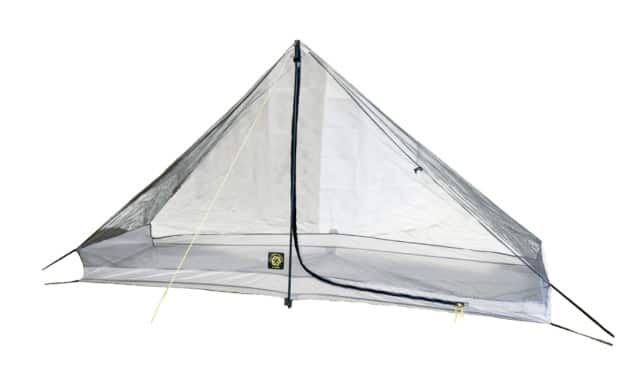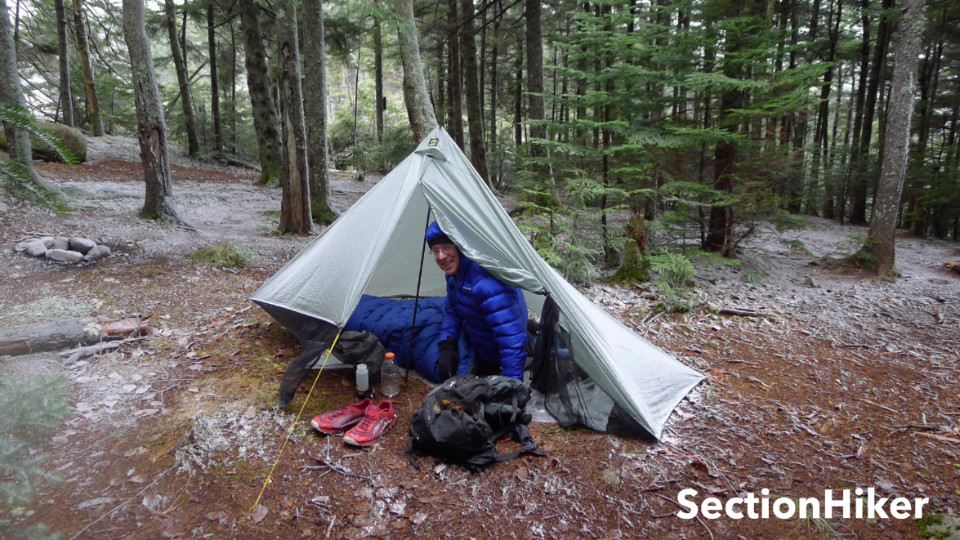There are four different types of ultralight bug shelters suitable for cowboy camping, sleeping in a lean-to, or underneath a flat tarp:
- Bivy Sacks
- Bug Bivies
- Net Tents
- Floorless Tarps w/ no-see-um Skirts
While they’re all similar in certain respects, they have distinct differences, pros, and cons. While bivy sacks are confining, they provide excellent insect protection. Bug bivies usually offer more living space, but are generally harder to get in and out of and must be suspended from a tarp or trekking poles. Net tents offer the most living space, but must also be used with trekking poles and tend to be the heaviest option. Floorless Tarps w/ no-see-um skirts sewn around their bottom perimeter are almost equivalent to a full tent but are usually used with some sort of footprint for dirt and moisture protection which can mitigate their weight savings.
Bivy Sacks

Ultralight bivy sacks do not have waterproof tops because they are intended to be used in dry conditions under a separate waterproof shelter in non-winter conditions. They should not be confused with much heavier waterproof bivy sacks used as tent replacements, such as the Outdoor Research Helium Bivy Sack.
Most ultralight bivy sacks have mesh hoods for insect protection and comfort with a solid, highly breathable fabric, covering the torso and legs. A waterproof floor is often included as convenience along with a zipper or drawstring closure. Grosgrain loops are usually included to suspend the mesh overhead with cord and to stake out the bivy sack corners. Bivy sacks made entirely with mesh tops can be problematic because insects can bite through the mesh if you are sleeping on top of your quilt or sleeping bag in hot weather instead of under or inside them. (see Katabatic Gear, Borah Gear, Mountain Laurel Designs).
- Advantages
- Provide wind and splashback protection under tarps. (Splashback is when water bounces off the ground near a tarp and back at you.)
- Good for insect and light dew protection when cowboy camping under the stars.
- Easy to use in a lean-to because they can be suspended from rafters and take no additional room.
- Provide inflatable sleeping bag protection when a pad is used inside bivy sack.
- They can be used like a sheet for insect protection in hot weather.
- Disadvantages
- More claustrophobic than alternatives
- Low to the ground so less waterproof against pooling water
- Usually not seam sealed or taped
Bug Bivies

Bug bivies are similar to bivy sacks but have sidewalls and must be suspended overhead using trekking poles or an overhead shelter. They’re usually offered with a waterproof floor. Many come with top zippers on the ridgeline which can be a little difficult to get in and out of depending on your ability to balance while stepping out of them. (see Mountain Laurel Designs, Paria Outdoor, SlingFin, Yama Mountain Gear).
-
- Advantages
- More living space
- Higher sidewalls provide better insect and water protection.
- Disadvantages
- Top door access can be awkward.
- Must be suspended at the ends using trekking poles or covering tarp
- Heavier than a bivy sack.
- More difficult to use in a crowded lean-to
- Leading Mfgs of Bug Bivies:
- Advantages
Net Tents

Net tents are the equivalent of an inner tent from a double-wall tent but are usually designed to be set up using trekking poles and staked out at the corners instead. Net tents have waterproof floors and a zippered entrance. If you are planning to combine a net tent with a tarp, it’s important to make sure that the door locations align properly for ease of access. (see Six Moon Designs, Hyperlite Mtn Gear, Mountain Laurel Designs).
-
-
- Advantages
- Lots of headroom so you can sit up inside and change clothing.
- Disadvantages
- Heavier than bivy sacks or bug bivies.
- More difficult to use in a crowded lean-to, especially if they have a side door
- Advantages
-
Floorless Tarps w/ no-see-um Skirts

Floorless tarps w/ no-see-um Skirts have netting that hangs below the bottom hem of the tarp, usually a mid-style shaped tarp, and closes the gap between the tarp and the ground. While they don’t provide the same degree of security that a single-wall tent with a floor does, they do a pretty good job at keeping flying and crawling insects and scorpions out of your shelter at night. (see Six Moon Designs).
- Advantages
- No additional setup up required since they’re part of your tarp
- A few ounces lighter weight than carrying a single wall shelter with a floor
- Provide some splashback protection in rain
- Remarkably effective at blocking
- Disadvantages
- No dirt or moisture protection underneath you; most people carry a footprint too
The Best of the Best
With the advantages and disadvantages of each bug shelter type in mind, here are the ultralight bug shelters that we would recommend taking a deeper look at if your goal is to assemble an ultralight shelter system. When choosing between these different bug shelter types it’s important to understand where you plan to use them, what the weather conditions will be like, as well as the tarp, if any, you intend to pair them with.
Additional Considerations
Zipper Location
On bivy shelters with zippers, it’s often more convenient to have a side zipper or one at the head end than a zipper that runs lengthwise down the center. If you’re sleeping under a tarp, there’s going to be limited headroom underneath it, particularly in inclement weather when it’s pitched low to the ground for more wind and rain protection. Bivy sacks with side zippers and bug bivies with end doors or side doors are easier to get out of compared to bivy sacks with center zippers or bug bivies with top zippers in the ridgeline.
Bathtub Floor and Sidewall Depth
If you have an all-mesh bivy sack or a bug bivy with mesh sidewalls and need to sleep on top of your sleep insulation on hot nights, insects can still bite you through the mesh. If you sleep on a 2″, 3″, or 4″ high inflatable pad, you might consider choosing a shelter with higher sidewalls made with solid insect-proof fabric instead of mesh.
Breathable fabrics
When choosing a bivy sack, try to get one with a highly breathable top fabric to help reduce the chance of internal condensation inside the bivy back. Avoid buying a bivy sack with a waterproof/breathable top fabric for warm weather use because they’re much more prone to internal condensation.
See Also:
SectionHiker is reader-supported. We only make money if you purchase a product through our affiliate links. Help us continue to test and write unsponsored and independent gear reviews, beginner FAQs, and free hiking guides.
